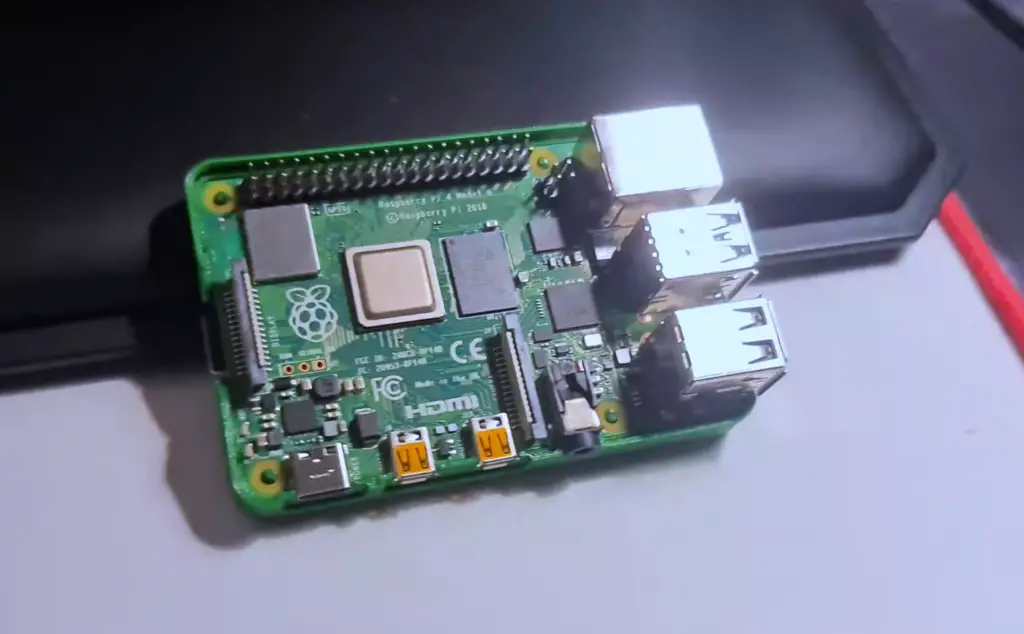NGINX is a popular web server that is known for its high performance and low resource usage. It is widely used in production environments to serve static content, reverse proxy, and handle load balancing.
For many developers and hobbyists, the Raspberry Pi has become their go-to platform for various projects. The combination of its low cost, small size, and versatility makes it an attractive choice for hosting websites and applications.
In this guide, we will go through the steps to install NGINX on your Raspberry Pi. We will cover both installation methods – using the terminal and using Raspbian’s graphical interface. By the end of this guide, you will have a fully functional web server running on your Raspberry Pi.
What is Nginx and why is it used?
Web server

Additionally, Nginx offers advanced load balancing capabilities, allowing it to distribute traffic evenly across multiple servers. This ensures high availability and prevents any single point of failure. Moreover, Nginx supports various protocols, including HTTP, HTTPS, SMTP, and WebSocket, making it a versatile solution for a wide range of applications.
Furthermore, Nginx provides extensive configuration options, allowing fine-tuning and customization to suit specific requirements. It also integrates seamlessly with other software, such as caching systems, content delivery networks (CDNs), and application servers, enhancing performance and optimizing content delivery.
Overall, Nginx has revolutionized the web server landscape with its speed, efficiency, and flexibility. Its continuous development and active community support ensure that it remains at the forefront of web server technology, empowering developers to deliver exceptional performance and reliability for their applications. [3]
Reverse proxy
In addition to its role as a powerful web server, NGINX also serves as a versatile reverse proxy, offering a wide range of capabilities. As a reverse proxy, NGINX not only receives requests from clients, but it also intelligently analyzes and forwards them to other servers, such as application servers or additional web servers. This intelligent routing enables efficient load balancing, ensuring the optimal distribution of traffic among multiple servers. By effectively managing the load, NGINX enhances overall performance and scalability, allowing organizations to handle high volumes of requests seamlessly.
Furthermore, NGINX’s comprehensive capabilities empower organizations to scale their web applications effortlessly in response to growing demands. With its advanced features, such as caching, SSL/TLS termination, and content compression, NGINX enables organizations to deliver content faster and more securely. This enhanced performance and security make NGINX an ideal choice for organizations seeking to provide exceptional user experiences while effectively managing their web infrastructure. [3]
Web proxy caching
NGINX, a widely used and highly regarded web server, goes beyond just delivering impressive performance. It boasts a sophisticated built-in caching mechanism that intelligently stores frequently accessed content in memory. This strategic caching approach leads to expedited content retrieval and minimized disk I/O operations. By reducing the reliance on disk-based content retrieval, NGINX elevates the performance of websites and applications, ensuring a seamless and efficient user experience. With NGINX, users can expect nothing short of exceptional speed, reliability, and overall performance. [3]
Can a Raspberry Pi run Nginx?
Absolutely! The Raspberry Pi is a highly versatile and capable device that can effortlessly handle hosting a web server such as Nginx. With its low cost and energy-efficient design, the Raspberry Pi proves to be an ideal platform for personal or small-scale projects.

To successfully run Nginx on your Raspberry Pi, it’s important to ensure that your device has sufficient resources. This includes having ample memory to handle multiple connections and enough disk space to accommodate your website or application files. Moreover, a stable internet connection is crucial for your server to be easily accessible from the internet.
When it comes to installing Nginx on Raspberry Pi, you’ll be delighted to know that the process is quick and straightforward. In the following sections, we will guide you through each step meticulously, ensuring a seamless and hassle-free setup. So, let’s dive right in and unlock the full potential of your Raspberry Pi web server! [1]
1. Update apt Repository
To begin the process of installing NGINX on your Raspberry Pi, it is crucial to ensure that your system’s apt repository is up-to-date. By doing so, you can guarantee access to the most recent software package versions for installation while avoiding any potential conflicts.
To update the apt repository, follow these steps:
- Open a terminal window on your Raspberry Pi.
- Enter the following command:
- `sudo apt-get update`
Executing this command will fetch the latest package information from the repository and synchronize it with your system. It is an essential step to ensure you have the most recent and stable versions of software packages available for installation.

Once the update process is completed, you’re all set to proceed to the next step with confidence. [1]
2. Install NGINX Server
With your apt repository updated, you can now proceed to install the NGINX server on your Raspberry Pi. To do so, follow these steps:
In the same terminal window, enter the following command:
`sudo apt-get install nginx`
This command will initiate the installation process of NGINX on your system. It will download the necessary files and dependencies, ensuring a smooth installation.
When prompted for confirmation, press `Y` to proceed. This step confirms your intention to install NGINX and allows the installation process to continue.
Once the installation is completed, you will see a success message confirming that NGINX has been successfully installed on your Raspberry Pi. This indicates that NGINX is now ready to be configured and used as a web server.
It’s time to move on to the next step and start configuring your new web server. By customizing NGINX’s settings, you can optimize its performance and tailor it to your specific needs. [1]

3. Start NGINX Server
With NGINX successfully installed, it’s time to start the server and ensure everything is working correctly. Follow these steps to do so:
In the same terminal window, enter the following command to initiate the NGINX service and start the web server:
“`
sudo systemctl start nginx
“`
This command will activate the NGINX service, initiating the web server and allowing it to handle incoming requests.
To verify that NGINX has started successfully, enter the following command:
“`
sudo systemctl status nginx
“`
This command will display the current status of NGINX. Upon successful start, you should see a message indicating that the service is active and running.
By following these steps, you can ensure that your NGINX server is up and running smoothly, ready to handle and serve your web applications. [1]
4. Check if NGINX is running
To double-check whether NGINX is running and accessible from your Raspberry Pi, you can perform a quick test. Follow these steps to do so:
- Open a web browser on your Raspberry Pi. This can be done by clicking on the browser icon located on your desktop or by navigating to the browser application in your system’s menu.
- In the address bar of the web browser, enter either `http://localhost/` or `http://127.0.0.1/`. Both of these addresses will lead you to NGINX’s default webpage, which is the page that is displayed when NGINX is successfully running on your system.
If the website loads successfully and you are able to see the NGINX default webpage, it confirms that NGINX is up and running on your Raspberry Pi. This is an important milestone and indicates that you have successfully installed and configured NGINX on your Raspberry Pi.
Congratulations on setting up NGINX! With NGINX running on your Raspberry Pi, you now have a powerful web server that can handle and serve your web applications with efficiency and reliability. [1]
5. Take your website to the Raspberry Pi
Now that you have your NGINX server up and running on your Raspberry Pi, it’s time to take your website to the next level by hosting it on this powerful platform. By doing so, you can harness the full potential of your Raspberry Pi and create a highly efficient and cost-effective web hosting solution.
Hosting a website on your Raspberry Pi allows for easy access and management of your website, with the added benefit of being able to run multiple websites on a single device. This makes it an ideal solution for small-scale or personal projects that don’t require a large and expensive hosting service.
To host your website on your Raspberry Pi, you can follow these steps:
- Ensure that your NGINX server is running by following the steps outlined in the previous sections.
- Copy your website’s files to the default web root directory of NGINX, which is located at `/var/www/html/`. You can do this by using a File Transfer Protocol (FTP) client or by manually transferring the files to the specified directory.
- Set up your domain name or IP address to point to your Raspberry Pi’s IP address. This can be done by configuring your DNS settings or setting up port forwarding on your router if you are using a dynamic IP address.
- Once your domain name is configured correctly, you should now be able to access your website through the internet by entering your domain name in a web browser. [2]

6. Edit the default website path
By default, NGINX serves the files located in `/var/www/html/` as the website content. However, if you want to host multiple websites or change the default location of your website’s files, you can do so by editing the server block configuration file.
To edit the default website path, follow these steps:
- Open the server block configuration file located at `/etc/nginx/sites-enabled/default` in a text editor. This file contains the settings for your NGINX server.
- In this file, locate the line `root /var/www/html;` which specifies the default directory for your website files. Change the directory path to point to your desired website directory. This allows you to customize the location where your website files are stored.
- Save the changes and exit the text editor. Make sure to double-check the modifications you made to ensure they are correct.
- Finally, restart NGINX by using the command `sudo systemctl restart nginx`. This will apply the changes and update the server configuration.
Your changes should now be implemented, and NGINX will serve your website’s files from the new directory specified.
With these steps, you can easily host multiple websites or change the default location of your website’s files on your Raspberry Pi. This allows for greater flexibility and customization options when using NGINX as a web server on your Raspberry Pi. [2]
7. Restart the NGINX Server
In some cases, you may need to restart the NGINX server for your changes to take effect or to troubleshoot any issues that may arise. This can be done by following a few simple steps:
- Open a terminal window on your Raspberry Pi. To do this, you can navigate to the “Applications” menu, select “Accessories,” and then choose “Terminal.”
- Once you have the terminal window open, you can proceed to the next step. Enter the command `sudo systemctl restart nginx` and press `Enter`. This command will initiate the restart process for the NGINX service.
- If prompted, you will need to enter your password and press `Enter`. This is required to authenticate and authorize the restart process.
- After entering your password, the restart process will begin. You may see some status messages indicating the progress of the restart. Once the process is complete, you should see a message indicating that NGINX has been successfully restarted.
By following these detailed steps, you can easily restart the NGINX server whenever necessary and ensure that your changes are applied correctly. This can help you troubleshoot any issues that may arise and maintain the smooth operation of your NGINX server. [2]
8. See the results on your browser
After successfully completing the installation, configuration, and hosting process of your website on NGINX, you can now experience the results firsthand in your web browser. Simply enter your domain name or IP address into the address bar, and voila! Your website’s captivating content will be elegantly displayed before your eyes.
By utilizing the power of NGINX on your Raspberry Pi, you have not only created a formidable web server but also unlocked a realm of possibilities to handle a diverse range of web applications. With its unrivaled flexibility to host multiple websites and the ability to effortlessly customize your website’s file path, NGINX proves to be an exceptional choice for web hosting on the Raspberry Pi platform.
Congratulations on successfully completing the intricate installation and meticulous configuration of NGINX on your Raspberry Pi. We genuinely hope that this comprehensive guide has provided you with valuable insights and equipped you with the necessary knowledge to set up a fully functional web server that can effortlessly serve your website with unparalleled ease and efficiency. [2]

FAQ
How to install NGINX in Linux terminal?
To install NGINX on Linux using the terminal, follow these steps:
- Open your Linux terminal by pressing Ctrl + Alt + T or searching for Terminal in your system’s applications.
- Update your system’s package list by entering the following command: `sudo apt-get update`
- To install NGINX, enter the following command: `sudo apt-get install nginx`
- The installation process will prompt you to confirm the installation by pressing `y` on your keyboard.
- Once the installation is complete, NGINX will be ready to use on your Linux system.
How to install NGINX step by step?
To install NGINX step by step, follow these instructions:
- First, make sure you have a Linux system with access to the internet.
- Open your terminal and update your package list using the command `sudo apt-get update`.
- Once the update is complete, use the command `sudo apt-get install nginx` to install NGINX on your system.
- Confirm the installation when prompted by pressing `y` on your keyboard.
- Wait for the installation to finish and then check if NGINX is successfully installed by entering the command `nginx -v`. It should display the version of NGINX installed on your system.
- **You can now start using NGINX on your Linux system.
How to install nginx in Linux 2?
To install NGINX on Linux 2 using the terminal, follow these steps:
- Open your Linux 2 terminal by pressing Ctrl + Alt + T or searching for Terminal in your system’s applications.
- Update your system’s package list by entering the following command: `sudo yum update`
- To install NGINX, enter the following command: `sudo yum install nginx`
- The installation process will prompt you to confirm the installation by pressing `y` on your keyboard.
- Once the installation is complete, NGINX will be ready to use on your Linux 2 system.
How to install nginx using shell script?
To install NGINX using a shell script, follow these steps:
- Create a new file with the extension `.sh` in your desired directory.
- Open the file and add the following code:
“`
#!/bin/bash
sudo apt-get update
sudo apt-get install nginx
“`
- Save and close the file.
- Make the `.sh` file executable by entering the command: `sudo chmod +x file_name.sh`
- Execute the script by entering the command: `./file_name.sh`
- The installation process will begin and prompt you to confirm, press `y` on your keyboard to continue.
- **Wait for the installation to finish and then check if NGINX is successfully installed by entering the command `nginx -v`. It should display the version of NGINX installed on your system.
- You can now start using NGINX on your Linux system.
Useful Video: How to Install an Nginx Web Server on Raspberry Pi
Conclusion
Installing NGINX on a Raspberry Pi or any Linux system is a straightforward process that can be accomplished using either the terminal or a shell script. By following the steps mentioned above, you can have NGINX up and running in no time, ready to serve your web applications with ease.
To get started, you’ll need to ensure that your Raspberry Pi or Linux system is connected to the internet and that you have administrative access. Once you have that, you can proceed to install NGINX by executing the necessary commands in the terminal or running a shell script specifically designed for this purpose.
After the installation is complete, you may want to customize the NGINX configuration to fit your specific needs. This can involve modifying settings such as port numbers, server blocks, or SSL certificates. You can find detailed documentation on how to configure NGINX on the official NGINX website.
In case you encounter any issues during the installation process, don’t panic! NGINX’s official documentation provides comprehensive troubleshooting tips and solutions to common problems. By referring to this documentation, you can quickly resolve any obstacles and continue with your NGINX setup.
So, go ahead and give it a try! Happy installing and enjoy the seamless performance that NGINX brings to your Raspberry Pi or Linux system.
References
- https://singleboardblog.com/install-nginx-on-raspberry-pi/
- https://www.themoderncoder.com/install-nginx-on-raspberry-pi/
- https://raspberrytips.com/nginx-on-raspberry-pi/













Leave a Reply